Algae are plant-like bacteria that frequently occur in water bodies like ponds, rivers, lakes, springs, and streams. Algae are of various types, but research indicates that well water usually contain 4 types of algae.
- Green Algae (chlorophyta)
- Red Algae (rhodophyta)
- Brown Algae (diatoms or bacillariophyta)
- Blue-Green Algae (cyanobacteria)
Harmful Algae Blooms (HABs) occur when blue-green algae (cyanobacteria) grow out of control and produce toxins. The toxins produced by cyanobacteria are called cyanotoxins. The common cyanotoxins found in well water are microcystin and cylindrospermopsin.
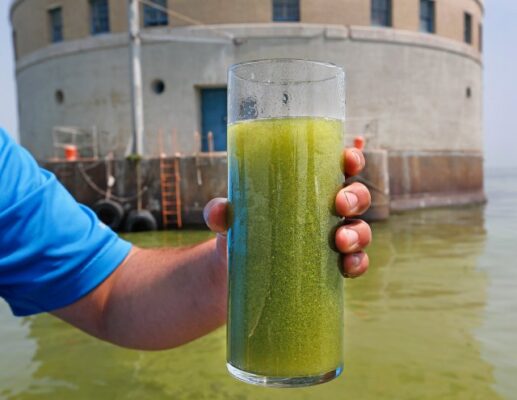
Image Source: U.S. Environmental Protection Agency, EPA
How Algae Forms in Well Water?
Algae grow in well water if not enclosed, warm, or still. Wells that are not used for a long time will suffer from algal growth. Well water also contains excessive nitrogen and phosphorous. These two elements are essential for algae to grow.
Well water with high pH is also a breeding ground for algae. Private wells located near agricultural sites or fertilizer storage areas are likely to have a high concentration of nitrogen and phosphorous.
How to Remove Algae from Well Water?
Chlorination is the most effective way to eliminate algae and other microorganisms from well water, such as bacteria and viruses. You can also use water filters, but chlorination gives better results and keeps your well safe for another 3-4 years.
Chlorination is a simple but time-taking process. CDC has outlined the process in detail to help you chlorinate your well. Most states allow well owners to chlorinate their wells, but you can hire a private well contractor if you think you can’t successfully complete the process.
Here are a few steps to help chlorinate your well and eliminate algae in well water.
- Start by clearing any debris around the well cap and check that area around the well is dry, so you don’t slip while working.
- Turn off electrical connections to your well before disinfecting.
- You’ll need household bleach, a water bucket, hose, and funnel to complete the process.
- Close all valves to the water softener, filters, or other water treatment systems installed at your home.
- You’ll need chlorine based on the volume of water in your well, the diameter of the well (bored or dug wells), or the diameter of the well casing (for drilled or driven well). CDC has outlined chlorine requirements for private wells. It also explains the chlorination process in detail.
Amount of Bleach Required for Disinfection of a Bored or Dug Well according to Well Diameter
Depth of Water | 0.5 foot | 1 foot | 2 feet | 3 feet | 4 feet | 5 feet |
10 feet | 1/2 cup | 1-3/4 cups | 7 cups | 1 gal | 1-3/4 gal | 2-3/4 gal |
20 feet | 1 cup | 3-1/2 cups | 14 cups | 2 gal | 3-1/2 gal | 5-1/2 gal |
30 feet | 1-1/2 cups | 5-1/4 cups | 1-1/4 gal | 3 gal | 5-1/4 gal | 8-1/4 gal |
40 feet | 2 cups | 7 cups | 1-3/4 gal | 4 gal | 7 gal | 11 gal |
50 feet | 2-1/2 cups | 8-3/4 cups | 2-1/4 gal | 5 gal | 8-3/4 gal | 13-3/4 gal |
Amount of Bleach Required for Disinfection of a Drilled or Driven Well according to Diameter of Well Casing
Depth of Water | 2 inches | 4 inches | 6 inches | 8 inches | 10 inches | 24 inches | 36 inches |
10 feet | 3/4 tbsp | 3-1/4 tbsp | 1/2 cup | 3/4 cup | 1-1/4 cups | 7 cups | 1 gal |
20 feet | 1-1/2 tbsp | 6-1/2 tbsp | 1 cup | 1-1/2 cups | 2-1/2 cups | 14 cups | 2 gal |
30 feet | 2-1/4 tbsp | 9-3/4 tbsp | 1-1/2 cups | 2-1/4 cups | 3-3/4 cups | 1-1/4 gal | 3 gal |
40 feet | 3 tbsp | 13 tbsp | 2 cups | 3 cups | 5 cups | 1-3/4 gal | 4 gal |
50 feet | 3-3/4 tbsp | 1 cup | 2-1/2 cups | 3-3/4 cups | 6-1/4 cups | 2-1/4 gal | 5 gal |
100 feet | 7-1/2 tbsp | 2 cups | 5 cups | 7-1/2 cups | 12-1/2 cups | 4-1/2 gal | 10 gal |
- Check the tables above to see how much chlorine you should use for disinfection. CDC recommends using unscented household bleach for disinfecting well water and killing algae.
- Add 3-5 gallon water and required bleach in a 5-gallon bucket. Mix the solution.
- Remove the well cap and add bleach to the well.
- Use a garden hose to rinse the inside of the well casing for 5-10 minutes. Don’t forget to close the well cap after rinsing.
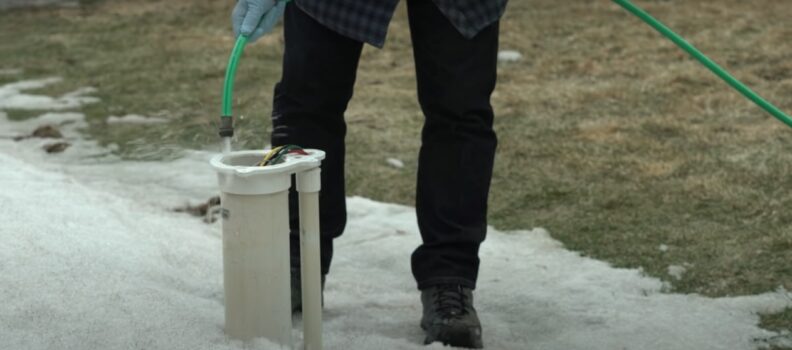
- Open all faucets inside the home and run the water until you notice a chlorine smell.
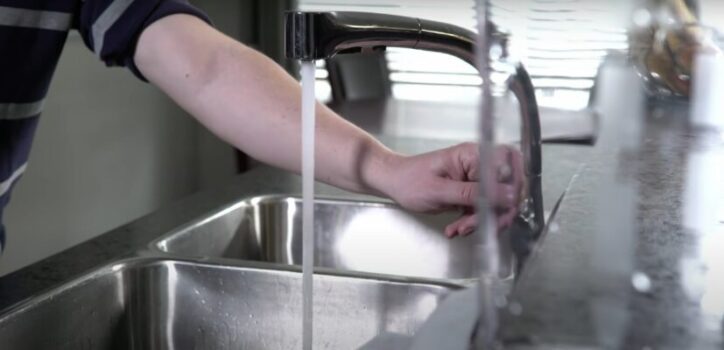
- Turn off all faucets and wait for at least 12-24 hours. The chlorine in bleach will effectively eliminate all the algae in well water.
- Attach a hose to the outside faucet after at least 12 hours and drain the chlorinated water onto an area without plants or vegetation. Keep the water running until the chlorine smell fades away.
- Run all the inside faucets to remove chlorinated water.
Pro Tips for Chlorination
- Store bottled water for drinking as you may have to wait up to 7-14 days after chlorination and 24-48 hours if you have a RO or carbon filter at home.
- It is better to use newly bought chlorine. Liquid chlorine loses its power over time.
- Wait 7-10 days to retest your water.
Read More: How Long Should You Wait To Use Water After You Chlorinate A Well?
Alternate Methods to Eliminate Algae in Well Water
Chlorine Injection System
A chlorine injection system is recommended for wells with recurring bacterial or algae contamination problems. The unit works by injecting a measured amount of chlorine according to the volume of water that passes through it.
However, it is maintenance-intensive, and you’ll have to refill chlorine periodically.
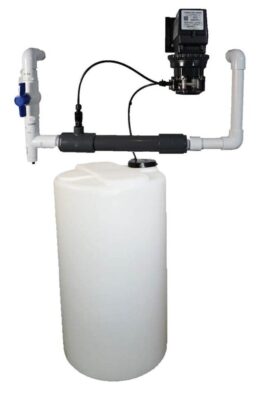
UV Purification System
Installing a UV purification system is the easiest way to remove algae from well water. UV light disintegrates bacteria, viruses, and algae DNA, making them harmless.
UV system doesn’t require frequent maintenance, but its high-end models are costly.
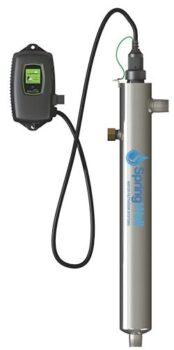
Algae in Well Water Storage Tanks
Algae growth in water tanks is another common problem many private well owners face. Here are three simple ways to eliminate algae growth in water tanks.
- Use an Opaque Water Storage Tank: Algae reproduces only in the presence of sunlight. Hence, algae will not grow if a water tank doesn’t allow light through the cap or side walls.
- Use Bleach: If you don’t have an opaque water tank, add a quarter teaspoon of bleach to every water gallon in your tank. This method is best for storing extra water like rainwater or spring water. It is best to use bleach that is 5.25% hypochlorite.
- Chlorine: Add 4 parts chlorine to every 1 million parts of water to stop algae growth. However, it adds a chlorine taste and smell to the water, but the water will be safe to drink and cook.
Make sure you follow bleach and chlorine ratios very carefully. Too much of these in water are harmful to your health. Moreover, do not add both bleach and chlorine together.
How to Test for Algae in Well Water?
Toxins produced by algae such as cyanobacteria do not change the water’s color, taste, or smell. Hence, a water test is the only reliable way to detect algae in well water. You can test for algae at home, but it is better to go for professional testing as the results are accurate and reliable.
Annual testing for algae is recommended if well is less than 60 feet deep, has a casing or screen that is less than 60 feet deep, and possesses casing seals that are 18 feet deep or less. Moreover, wells constructed before 1979 and don’t have any records must be tested at least once a year. Experts also recommend testing for Algae if E. coli is detected in well water, the water is discolored (bluish, greenish, or cloudy), and the ground around the well is highly permeable.
EPA Safe Limits for Algae in Well Water
- For children younger than school age, the maximum limit for Microcystins & Cylindrospermopsin, produced by blue-green algae (cyanobacteria), is 0.3 parts per billion and 0.7 ppb, respectively.
- For adults, the MCL is 3 ppb for cylindrospermopsin and 1.6 ppb for microcystin.
The water test after disinfection must show values below these levels. You can contact your local health office if you need guidance on interpreting the results and removing algae from the well water.
Health Problems Caused by Algae in Drinking Water
- Stomach cramps
- Diarrhea
- Vomiting
- Numbness
- Tingling
- Dizziness
- Kidney and liver damage (prolonged exposure)
Frequently Asked Questions
Can I boil Well Water Contaminated with Algae?
No. Boling algae-contaminated doesn’t kill toxins. On the contrary, it may increase toxin concentration. However, you can boil water once it has been disinfected.
Can I use Algae-contaminated Well Water for baths, showers, washing dishes & laundry?
Yes. You can algae-contaminated water for all purposes other than cooking and drinking. Make sure you don’t swallow water while showering. If an algae advisory is issued, it is advised to reduce showering time and supervise children while showering.
Can Water Filters Remove Algae Toxins?
Some filters like RO and carbon filters can remove algae toxins, but it is recommended not to use them. The toxins can cling to the surface and may reduce the filter’s overall effectiveness and flow rate.
How to Remove Algae from Water Filters?
The best way out is to replace the cartridges, wash the housings with soapy water and rinse thoroughly before putting them back with a new cartridge. However, you can also rinse old cartridges and see if it works. Do not use soap, bleach, or chlorine on filter cartridges.
